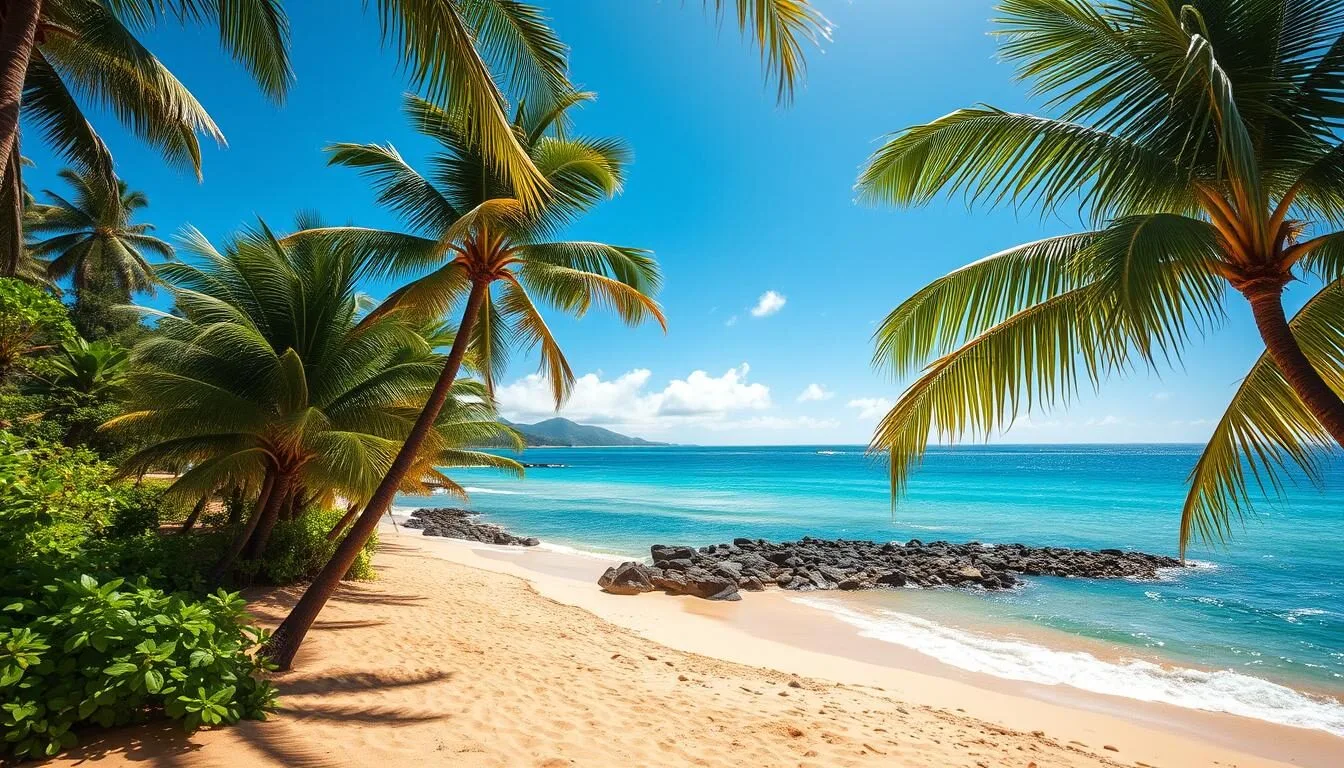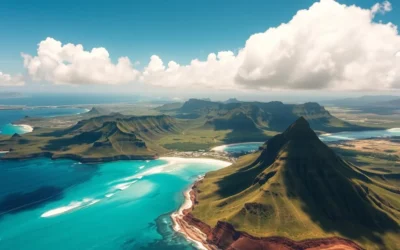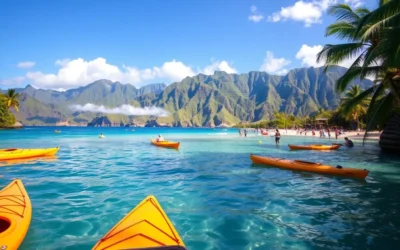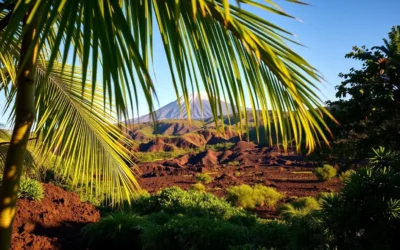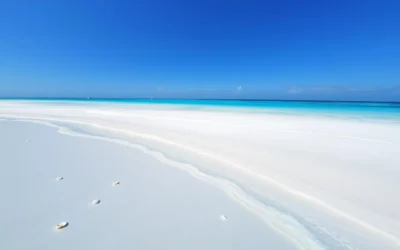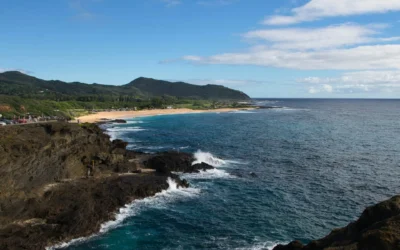✓ Accommodations ✓ Flights ✓ Rental Cars ✓ Tours & Activities
Imagine yourself on a serene island getaway, surrounded by lush landscapes and tranquil beaches. Visiting Molokai, Hawaii can be a dream come true, but timing is everything to make the most of your trip.
Understanding the unique weather patterns of this unspoiled Hawaiian island is crucial to maximizing your experience. Unlike more touristy destinations, Molokai offers an authentic glimpse into traditional life with fewer crowds year-round.
As you plan your trip, you’ll want to know the best time to visit, balancing pleasant temperatures, minimal rainfall, and optimal conditions for outdoor adventures. Whether you’re seeking sunny beach days or budget-friendly travel periods, this guide will help you plan the perfect weather-savvy trip.
Discovering Molokai: Hawaii’s Unspoiled Island
Discover the unspoiled charm of Molokai, Hawaii’s hidden gem, where tradition meets breathtaking landscapes. As you plan your trip to this unique island, understanding the local weather patterns and climate conditions becomes essential to making the most of your visit.
What Makes Molokai Unique Among Hawaiian Islands
Molokai stands out among the Hawaiian Islands for its pristine landscapes and untouched cultural heritage. Unlike more developed islands, Molokai’s appeal lies in its outdoor experiences, from exploring ancient valleys to enjoying its pristine beaches. The island’s distinct microclimates significantly impact the experience, making it crucial to plan your visit at the right time.
Why Weather Considerations Matter for Your Molokai Visit
Understanding Molokai’s weather is vital for a successful trip. The island’s climate varies throughout the year, with temperatures ranging from 73°F to 86°F. The topography creates notable differences between the dry leeward regions and the wetter windward areas, affecting accessibility to certain attractions. Planning your visit around Molokai’s weather patterns ensures you experience the island’s natural beauty at its best.
| Season | Weather Conditions | Ideal Activities |
|---|---|---|
| Dry Season (April-October) | Less rainfall, warmer temperatures | Beach activities, hiking |
| Wet Season (November-March) | More rainfall, slightly cooler temperatures | Lush landscapes, cultural events |
By considering the time of your visit and the prevailing weather conditions, you can tailor your trip to enjoy the best that Molokai has to offer, whether you’re seeking sunny beach days or lush green landscapes following seasonal rains.
Molokai’s Climate Overview: What to Expect Year-Round
As you plan your visit to Molokai, it’s helpful to understand the island’s climate patterns. Molokai’s weather is influenced by its unique topography and geographical location, creating diverse conditions across the island.
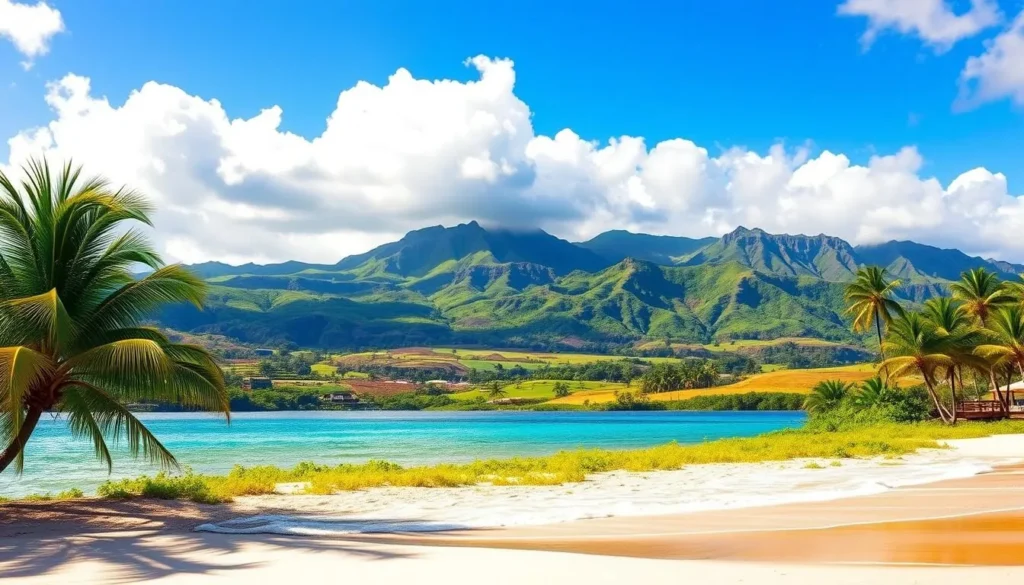
Temperature Patterns Throughout the Year
Molokai’s temperature varies throughout the year, but the island generally enjoys warm weather. The average temperature ranges from 70°F to 85°F, making it an attractive destination for travelers seeking pleasant conditions. During the winter months, temperatures can dip slightly, but they remain mild compared to many other parts of the world.
The consistent warmth is one of the island’s appealing features, allowing for outdoor activities year-round. However, it’s essential to consider the broader climate context, including rainfall and trade winds, to fully appreciate Molokai’s weather patterns.
Rainfall Distribution and Microclimates
Molokai’s rainfall varies significantly by location, with the eastern end receiving much more rain than the western areas. The island’s unique topography creates distinct microclimates, resulting in dramatic variations in annual rainfall. For instance, the eastern mountains can receive over 100 inches of rain annually, while the western lowlands might get less than 15 inches.
- The eastern side, including Halawa Valley, is much wetter due to the prevailing trade winds pushing moisture-laden clouds against the mountains.
- The western and southern shores remain drier throughout the year, benefiting from a rain shadow effect.
- Winter months bring more precipitation island-wide, though showers are often brief and localized.
- Understanding these rainfall patterns can help you plan your activities and accommodations, making the most of your visit to this beautiful island.
By considering these climate factors, you can tailor your trip to enjoy the best of what Molokai has to offer, from lush landscapes to sunny beaches.
The Dry Season: April Through October
The dry season, spanning from April to October, is an ideal time to visit Molokai, offering perfect conditions for outdoor activities and exploration of the island’s natural attractions. During these months, you can expect a significant reduction in rainfall, making it an excellent period for visitors to enjoy the island’s beach and outdoor activities.
Temperature and Precipitation Statistics
During the dry season, Molokai experiences warm temperatures, ranging from 70°F to 85°F (21°C to 30°C). The average precipitation during these months is significantly lower, with most areas receiving less than 2 inches of rainfall per month. This dry spell is characterized by plenty of sunshine and calm ocean conditions, making it ideal for water sports and outdoor exploration.
Benefits of Visiting During Drier Months
Visiting Molokai during the dry season provides numerous benefits. The reliable weather allows for uninterrupted exploration of the island’s outdoor attractions, from the remote Kalaupapa Peninsula to the pristine beaches along the western shore. The calm ocean conditions create ideal circumstances for snorkeling, paddleboarding, and swimming in Molokai’s protected reef areas. Additionally, the dry weather makes hiking trails more accessible, with less mud and more manageable stream crossings, especially for popular excursions like the Halawa Valley cultural hikes.
The dry season is considered the best time to visit Molokai for an optimal experience. With its pleasant weather and ideal conditions for outdoor activities, you can make the most of your trip and enjoy a memorable island getaway.
The Wet Season: November Through March
The wet season on Molokai, spanning from November to March, is a period of significant transformation, offering a distinct flavor to your island getaway. This time of year brings about lush landscapes and a host of unique experiences that differentiate it from the drier months.
What to Expect During Rainier Months
During the wet season, Molokai experiences a significant increase in rainfall, which rejuvenates the island’s vegetation, making it particularly lush and green. This period coincides with the humpback whale migration, offering visitors the spectacular opportunity to witness these magnificent creatures breaching and playing in the channel between Molokai and Maui from December through April.
- The island’s waterfalls are at their most dramatic, and the landscapes are vibrant and photogenic.
- Fewer crowds mean a more intimate experience of the island, with less crowded beaches and trails.
- Travelers can enjoy the island’s natural beauty without the peak season hustle.
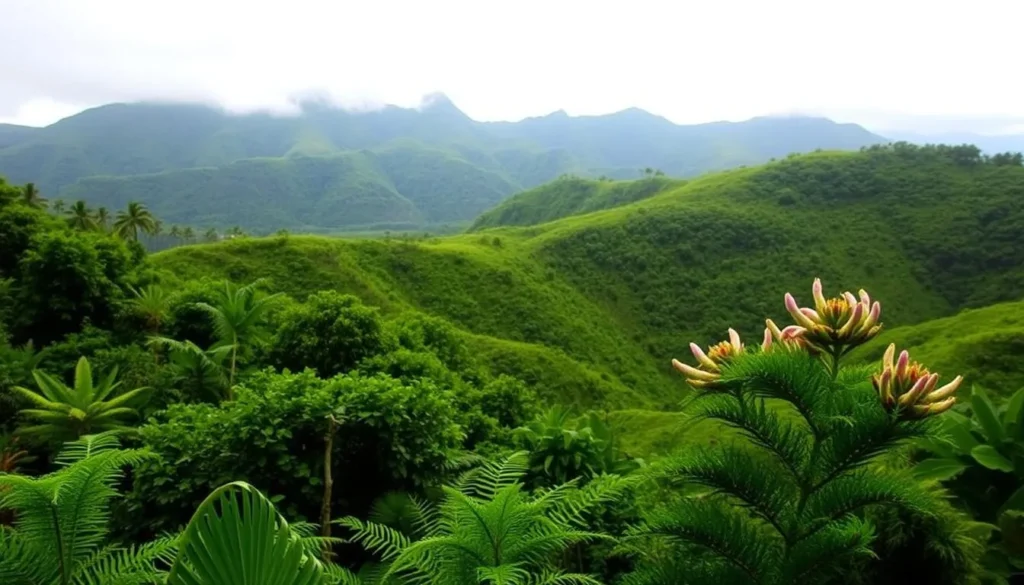
Why Some Travelers Prefer the Wet Season
Despite being the wetter months, this period has its advantages. Many travelers appreciate the vibrant green landscapes and the dramatic waterfalls. The wet season is also considered a best time for whale watching, as humpback whales migrate to the waters around Molokai.
| Aspect | Wet Season (Nov-Mar) | Dry Season (Apr-Oct) |
|---|---|---|
| Landscape | Lush and green | Drier, less green |
| Crowds | Fewer visitors | More visitors |
| Prices | Generally lower prices for accommodations | Higher prices due to peak season |
| Whale Watching | Peak season for humpback whales | Not available |
For those planning a trip to Molokai during the winter months, it’s essential to pack accordingly and be prepared for occasional rain showers. However, the experience is enriched by the unique activities and landscapes available during this time.
Summer in Molokai (June-August): Peak Season Analysis
Molokai’s summer, spanning from June to August, is a time of heightened activity, though the island retains its tranquil atmosphere. During these months, the island experiences its peak visitor season, attracting families on school vacations and other travelers seeking warm weather.
Weather Conditions and Ocean Temperatures
Summer brings warm temperatures to Molokai, with average highs often reaching the mid-80s Fahrenheit. The ocean temperatures are also at their warmest, making it an ideal time for swimming, snorkeling, and other water activities. The warm and relatively dry conditions make summer an excellent time for outdoor exploration, including visits to Molokai’s beautiful beaches and natural attractions.
Crowd Levels and Accommodation Availability
While summer is considered peak season, Molokai remains less crowded than other Hawaiian islands. Even at its busiest, popular beaches like Papohaku offer ample space for visitors to relax. However, accommodation options, particularly oceanfront condos and vacation rentals, tend to book in advance. Prices for these accommodations typically increase by 10-20% during the summer months, reflecting the higher demand. Visitors are advised to plan ahead to secure their preferred lodging.
The demographic of visitors during the summer months shifts slightly, with more families arriving due to school vacations. This change adds to the island’s lively atmosphere while still maintaining its overall unhurried pace. For travelers considering a visit during this time, it’s essential to balance the benefits of warm weather and family-friendly activities with the potential for higher prices and the need to book accommodations early.
Fall in Molokai (September-November): The Sweet Spot
The autumn months offer a sweet spot for travelers to Molokai. As the summer crowds dissipate, the island becomes even more tranquil, offering visitors a serene and peaceful experience. The fall season brings a unique charm to Molokai, making it an excellent time to enjoy the island’s natural beauty.
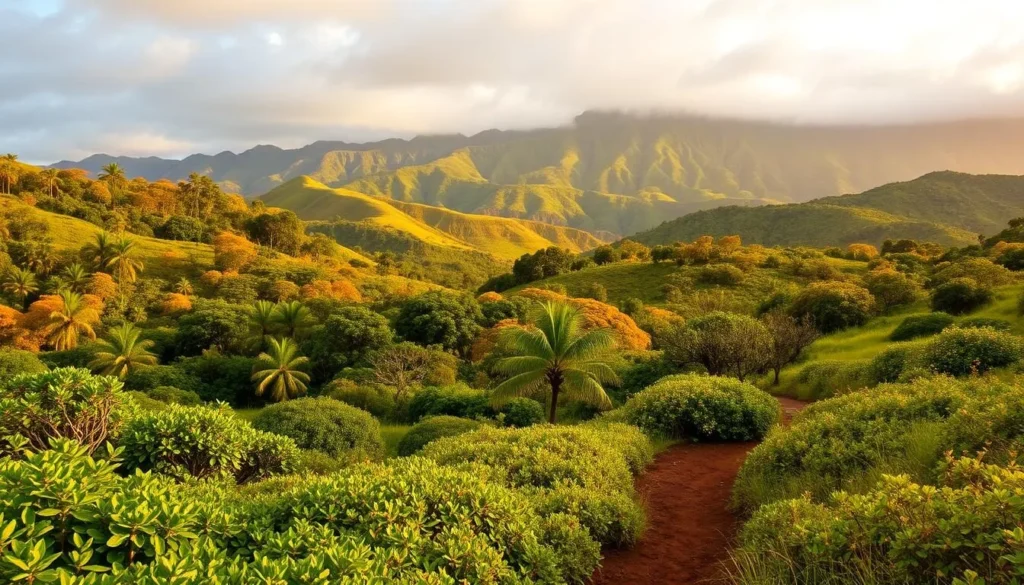
Weather Patterns During Autumn Months
During the fall, Molokai experiences pleasant weather, with temperatures ranging from 70°F to 85°F. The autumn months see a slight increase in humidity, which creates spectacular sunset conditions and adds drama to landscape photos. The weather patterns during this time are ideal for outdoor activities such as hiking, snorkeling, and photography.
- The average high temperature in September is 84°F, making it perfect for beach activities.
- October sees a slight drop in temperature, with averages ranging from 75°F to 80°F.
- November marks the beginning of the cooler season, with temperatures ranging from 70°F to 75°F.
Why September and October Offer Excellent Value
September and October are considered the best time to visit Molokai, offering a perfect balance of summer-like weather without the peak season crowds or prices. Accommodation rates typically drop 15-25% from their summer highs during these months, while availability improves significantly, giving visitors more options and better value.
| Month | Average Temperature | Accommodation Rate |
|---|---|---|
| September | 80°F | 15% lower than summer |
| October | 78°F | 20% lower than summer |
| November | 75°F | 25% lower than summer |
As the fall season progresses, the island feels even more tranquil, making it an ideal time to visit Molokai. Whether you’re looking for relaxation, adventure, or cultural experiences, Molokai in the fall has something to offer.
Winter in Molokai (December-February): The Rainy Season
Experience the softer side of Molokai during winter, with lush landscapes and spectacular marine life encounters. As the rainy season sets in, the island transforms, offering a unique winter experience that’s both tranquil and adventurous.
Navigating Winter Showers and Storm Patterns
Winter brings increased rainfall to Molokai, resulting in lush vegetation and full reservoirs. While showers are frequent, they often come in short bursts, allowing for plenty of sunshine throughout the day. Understanding the storm patterns can help you plan your activities and make the most of your visit. The rain also brings life to the island’s eastern valleys, creating seasonal waterfalls that are a breathtaking sight.
The west-facing shores of Molokai are particularly noteworthy during winter, as they offer excellent opportunities for land-based whale watching. You can often spot humpback whales breaching and spouting from scenic lookouts without needing a boat tour.
Winter-Specific Activities and Attractions
Winter on Molokai is not just about the rain; it’s a season filled with exciting activities and attractions. Some highlights include:
- Whale Watching: The channel between Molokai and Maui is one of the world’s best whale watching locations from December through April.
- Surfing: Winter’s rougher ocean conditions create exciting surf along Molokai’s north shore, attracting experienced surfers.
- Exploring Seasonal Waterfalls: The increased rainfall brings the island’s eastern valleys to life, with spectacular cascades visible during hikes.
- Marine Life Encounters: Winter brings subtle changes to Molokai’s underwater world, with different fish species becoming more prevalent and occasional sightings of pelagic marine life like manta rays.
By understanding and embracing the characteristics of Molokai’s winter season, you can have a rewarding and memorable visit, enjoying the island’s natural beauty and outdoor activities.
Spring in Molokai (March-May): Transition Season
You can enjoy a blend of whale watching and pleasant weather in Molokai during the spring months. As the island transitions from winter to summer, it offers a unique combination of experiences for visitors.
Weather Trends as Winter Transitions to Summer
During spring, Molokai’s weather steadily improves, making it ideal for land-based activities. The island’s vegetation is at its peak lushness following the winter rains, creating spectacular scenery for hiking and photography. As the rainfall decreases, the water clarity improves, making April and May excellent months for snorkeling and diving. The ocean temperatures remain comfortable, ranging around 76-78°F, enhancing the overall experience.
Unique Spring Experiences on the Island
Spring on Molokai offers a range of unique experiences. You can continue whale watching through April and occasionally into May. The island sees fewer visitors than in winter or summer, creating a sweet spot for travelers seeking both good weather and a more solitary experience of Molokai’s natural beauty. Additionally, cultural activities and community events increase during spring, giving you opportunities to engage with local traditions and celebrations.
| Month | Weather Conditions | Activities |
|---|---|---|
| March | Transitioning from winter, still some rainfall | Whale watching, early spring festivities |
| April | Improving weather, less rainfall | Snorkeling, diving, cultural events |
| May | Pleasant temperatures, clearer waters | Hiking, photography, community celebrations |
Spring is considered one of the best time to visit Molokai, offering a balance of pleasant weather and exciting activities. Whether you’re interested in exploring the island’s natural beauty or participating in local events, spring provides a wonderful opportunity to experience Molokai’s unique charm.
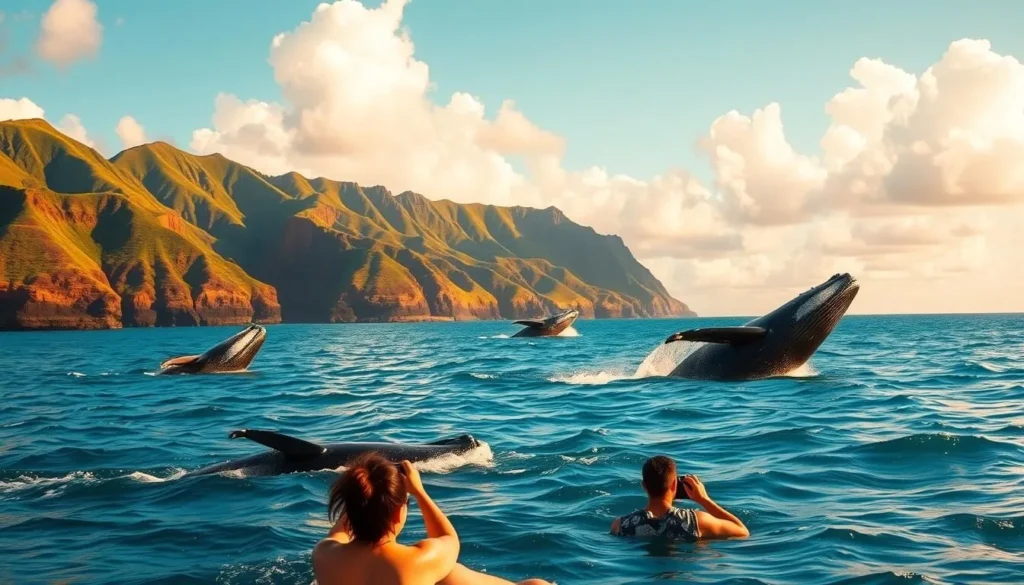
Molokai, Hawaii: Best Months for a Weather-Savvy Trip
When planning your trip to Molokai, Hawaii, timing is everything to ensure a weather-savvy vacation. The island offers a unique climate that can significantly impact your travel experience. Understanding the best times to visit can help you make the most of your trip.
April-May: Ideal Shoulder Season
The months of April and May represent an ideal shoulder season for visiting Molokai. During this period, you can enjoy warm temperatures without the peak season crowds. The weather is generally pleasant, making it perfect for outdoor activities. Accommodation prices are also relatively lower compared to the peak summer months, offering excellent value for your money.
September-October: Perfect Weather-Price Balance
September and October are considered by many to be the best times to visit Molokai. These months offer a perfect balance of summer-like weather conditions and post-peak season prices. You can enjoy warm temperatures (84-86°F) and clear skies, while ocean temperatures reach their annual peak around 80°F, ideal for extended water activities. With minimal rainfall, especially on the western and southern shores, you can virtually guarantee perfect weather for outdoor exploration. Moreover, accommodation prices typically drop by 15-25% from their summer peak, and availability improves significantly, creating an even more authentic experience of Molokai’s unhuried lifestyle and uncrowded natural attractions.
By choosing to visit Molokai during these periods, you can enjoy the best of what the island has to offer while making the most of your travel budget. Whether you’re looking for a relaxing getaway or an action-packed adventure, Molokai has something for everyone during these ideal months.
Water Activities and Ocean Conditions by Season
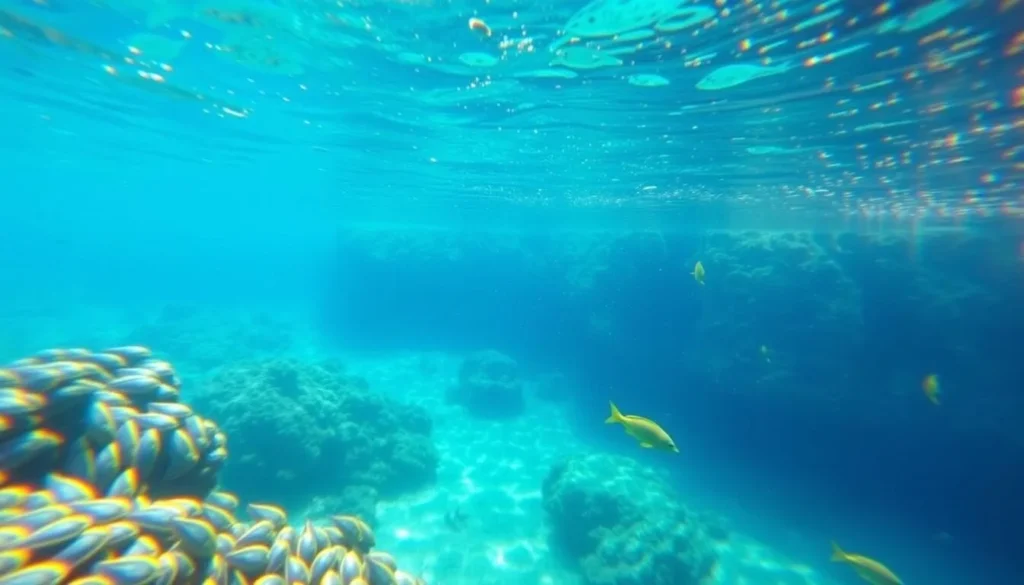
Molokai’s ocean conditions vary significantly throughout the year, making it essential to plan your water activities according to the season. The island offers a diverse range of experiences for water enthusiasts, from surfing and snorkeling to paddleboarding and kayaking.
Swimming and Snorkeling Conditions Throughout the Year
The calm waters of Molokai’s south shore provide ideal conditions for swimming and snorkeling during the summer months. The ocean is generally calm, with minimal winds, making it perfect for beginners and experienced snorkelers alike. In contrast, the winter months bring larger surf to the north-facing shores, which may not be suitable for all water activities.
During the shoulder seasons of late spring and early fall, the ocean conditions offer a balance between the calmness of summer and the rougher waters of winter. This makes these periods ideal for those looking for versatile water sports conditions.
Surfing and Water Sports: Seasonal Considerations
Molokai’s water sports conditions vary dramatically by season. Winter (November-March) attracts experienced surfers to the north-facing shores with larger surf and uncrowded waves. Summer and early fall create ideal conditions for paddleboarding, kayaking, and outrigger canoeing along the protected south shore, with calm waters and minimal winds.
The trade winds during the summer months also create perfect conditions for windsurfing and kiteboarding along the island’s eastern shores. For those new to water sports, the protected waters inside Molokai’s south shore reef system provide year-round opportunities for learning.
Whale Watching and Marine Life Seasons
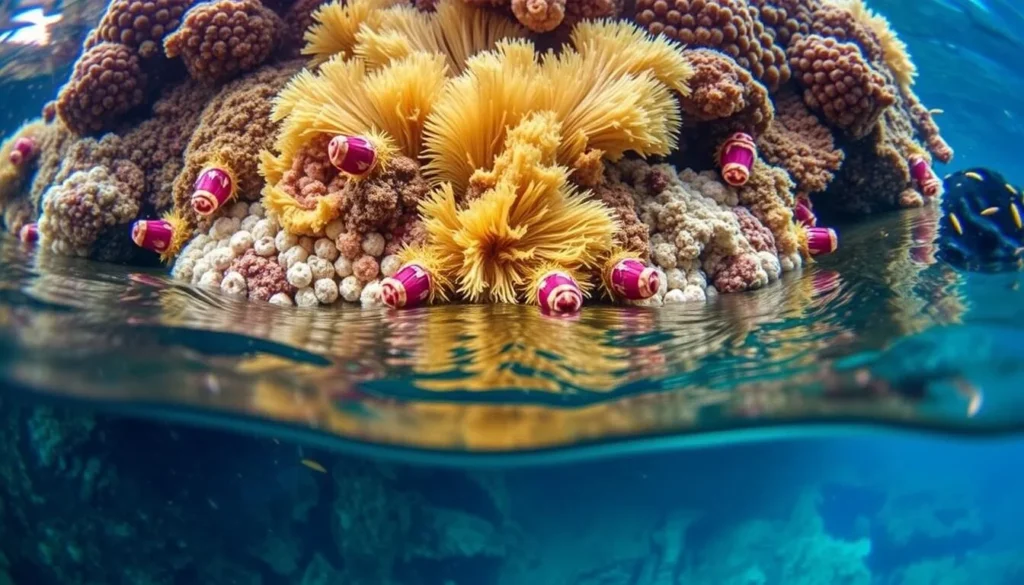
As you explore Molokai, you’ll discover its waters are teeming with life, from majestic humpback whales to colorful tropical fish. The island’s marine ecosystem is rich and varied, offering a unique experience in every season.
Humpback Whale Migration Period
Molokai’s waters are a critical habitat for humpback whales, which migrate to Hawaiian waters from December to May. During this period, you can witness these magnificent creatures breaching and singing in the island’s waters. The peak months for humpback whale watching are January and February, when the whales are most active.
Other Marine Life Encounters by Season
Molokai’s waters host abundant marine life year-round. Here are some of the encounters you can expect by season:
- Green Sea Turtles: Commonly spotted in nearshore waters during all seasons, particularly along the south shore reef system.
- Tropical Fish: Summer brings warmer water temperatures, increasing the activity of tropical fish species, making it the best time for colorful reef fish encounters while snorkeling or diving.
- Spinner Dolphins: Frequently visit Molokai’s south shore waters throughout the year, with their playful displays most commonly observed during early morning hours.
- Manta Rays: Occasionally visit the waters around Molokai, with sightings more common during summer and fall months when plankton concentrations increase.
- Hawaiian Monk Seals: These endangered natives occasionally haul out on Molokai’s remote beaches, with sightings possible year-round but requiring respectful distance.
Whether you’re snorkeling, diving, or simply enjoying the beach, Molokai’s waters offer an unforgettable experience. The best times to visit depend on what you want to see, but every season brings its own unique marine life encounters.
Hiking and Land Activities: Weather Considerations
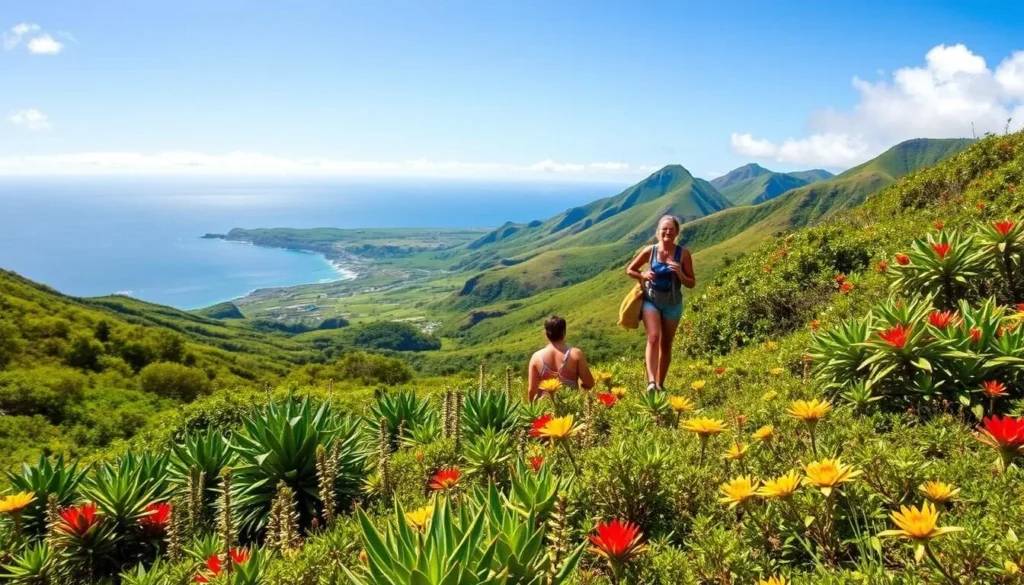
As you plan your hiking trip to Molokai, understanding the seasonal weather patterns is crucial. The island’s diverse landscapes, from rainforests to arid areas, offer a unique hiking experience that changes significantly with the seasons.
Trail Conditions Throughout the Year
Molokai’s hiking trails are accessible year-round, but trail conditions vary with the weather. During the winter months (December to February), trails can be muddy and slippery due to increased rainfall. In contrast, the dry season (April to October) offers clearer paths and more favorable hiking conditions.
The shoulder seasons of spring (March to May) and fall (September to November) often provide the best balance between comfortable weather and manageable trail conditions, making them ideal for hiking and land activities.
Scenic Viewpoints and Photography: Optimal Seasons
Different seasons offer unique photographic opportunities on Molokai. For landscape photography enthusiasts, each season on the island offers distinct advantages.
- For capturing Molokai’s lush, green character, late winter through spring provides the most vibrant landscapes following the rainy season.
- Summer provides the most reliable clear weather for capturing the island’s sweeping vistas, including breathtaking views from Palaau State Park’s Kalaupapa Lookout.
- The shoulder seasons of spring and fall often deliver the best sunset photography conditions, with occasional clouds adding color and dimension to the sky.
Early morning photography benefits from the calm conditions before trade winds pick up, with winter mornings occasionally offering mystical fog in the island’s higher elevations.
Cultural Events and Festivals by Season

As you plan your visit to Molokai, you’ll find that the island hosts a variety of cultural events and festivals that showcase its authentic Hawaiian spirit. These events offer a unique opportunity to experience the island’s rich cultural heritage and community life.
Annual Celebrations and Their Weather Contexts
Molokai’s cultural calendar is filled with exciting events that are influenced by the island’s seasonal weather patterns. For instance, the Molokai Holokai Paddle Festival, typically held in May, celebrates the island’s strong connection to paddling sports when ocean conditions are becoming more favorable.
The summer months bring community fishing tournaments, which offer visitors a chance to observe traditional fishing practices and the importance of seafood in island life. These events are usually held when ocean conditions are optimal, making summer an ideal time for water activities.
Community Events Worth Planning Around
Throughout the year, Molokai hosts smaller community events that welcome respectful visitors, providing authentic glimpses into local life. The Saturday farmers markets in Kaunakakai, the main town, run year-round, regardless of the weather, offering opportunities to interact with local farmers and artisans.
Church events, including holiday celebrations and summer luaus, occasionally welcome visitors and provide authentic cultural experiences that are far removed from the tourist-oriented productions found elsewhere in Hawaii. By attending these events, you can gain a deeper understanding of the island’s culture and community.
Budget-Conscious Timing: Prices by Season
To save money on your Molokai trip, it’s essential to consider the seasonal pricing trends. Understanding how prices fluctuate throughout the year can help you plan a more budget-friendly visit.
Accommodation Rate Fluctuations Throughout the Year
Accommodation rates on Molokai tend to follow the typical Hawaiian tourism patterns. Prices are generally higher during peak seasons, such as summer and winter holidays, and lower during the shoulder seasons of spring and fall. Booking your accommodations well in advance can help you secure better rates, especially during peak periods.
It’s also worth noting that the availability of accommodations can become limited during peak seasons, making advance reservations crucial. If you’re flexible with your travel dates, consider visiting during the shoulder seasons when prices are more favorable.
Flight Prices and Transportation Costs by Season
Flights to Molokai, which typically connect through Honolulu or Maui, follow the usual Hawaiian tourism price patterns. Prices are highest during summer and the December holiday season, and lowest during the fall and spring shoulder seasons. The limited flight schedule to Molokai means that price variations are less extreme than those for direct mainland-to-Hawaii routes, making it advisable to book flights well in advance.
- Flights to Molokai are typically more expensive during peak summer and winter holiday periods.
- Consider packaging your Molokai visit with stops on other Hawaiian islands for potential savings on airfare.
- Car rental prices remain relatively stable throughout the year, but advance reservations are essential, especially during peak periods.
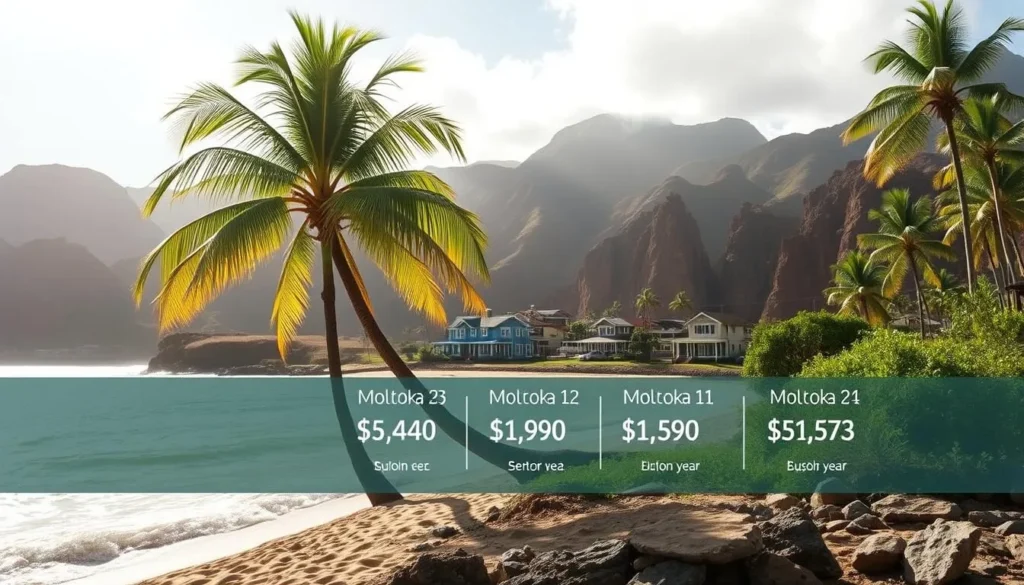
Weather-Related Travel Tips for Molokai
When planning your trip to Molokai, understanding the island’s weather patterns is crucial for a smooth and enjoyable journey. The island’s climate can vary significantly across different regions and times of the year.
What to Pack Based on Your Travel Month
Packing appropriately for your visit to Molokai depends largely on the time of year you plan to travel. During the winter months, it’s wise to include rain gear and layers for cooler evenings. In contrast, the dry season, which spans from April to October, calls for lighter clothing and sun protection.
Dealing with Unexpected Weather Changes
Molokai’s weather can change rapidly, particularly during winter when rain showers can develop quickly. To make the most of your trip, remain flexible with your plans. Here are some tips for dealing with unexpected weather changes:
- Always have indoor backup options during the rainy season.
- Take advantage of the island’s varied microclimates by “chasing the sunshine” to drier areas.
- Check weather forecasts daily during winter and schedule important outdoor activities early in your trip.
- Be aware of flash flood risks, especially when hiking or crossing streams.
| Season | Weather Conditions | Recommended Preparations |
|---|---|---|
| Winter (Dec-Feb) | Rainy, cooler temperatures | Rain gear, layers for cooler evenings |
| Dry Season (Apr-Oct) | Sunny, dry | Light clothing, sun protection |
Conclusion: Planning Your Perfect Molokai Getaway
The best time to visit Molokai ultimately depends on your personal priorities, whether you’re seeking perfect beach weather, whale watching opportunities, budget-friendly options, or cultural experiences.
For an ideal combination of favorable weather, reasonable prices, and manageable visitor numbers, consider the shoulder seasons of April-May and September-October. These periods consistently offer the best overall experience on the island.
If you prefer the most reliable sunny weather and warmest ocean temperatures, summer (June-August) is ideal for water-focused vacations, despite slightly higher prices and increased visitors.
On the other hand, winter (December-March) offers unique advantages for wildlife enthusiasts, with peak whale watching opportunities. However, be prepared for possible rain showers and plan your activities accordingly.
Regardless of when you visit Hawaii, Molokai rewards travelers seeking an authentic experience. The island’s natural beauty, cultural heritage, and aloha spirit remain intact, away from commercialized tourism.
Consider combining your Molokai visit with time on neighboring islands like Maui or Oahu to enhance your experience. Allow Molokai’s unhurried pace to guide your visit, and you’ll connect with the land, culture, and essence of Hawaii.
A weather-savvy approach to timing your Molokai trip will ensure you experience the best this special island has to offer.
The above is subject to change.
Check back often to TRAVEL.COM for the latest travel tips and deals.
